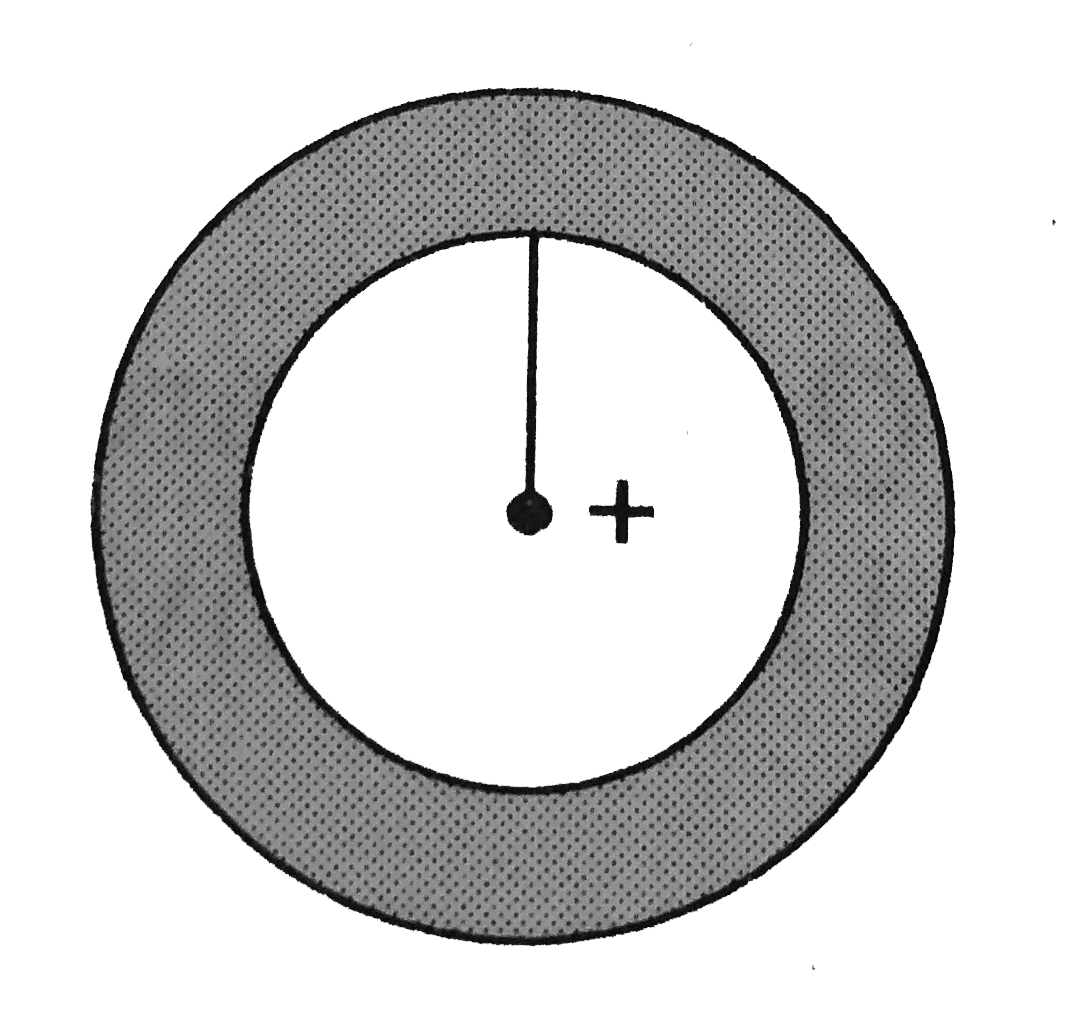The electric potential inside a conducting sphere
increases from cente to surface
decreases from cente to surface
remians constant from centre to surface
is zero at every point inside
The correct Answer is:C
Step-by-Step Solution:
1. Understanding the Conducting Sphere:
- A conducting sphere is a conductor that has a uniform distribution of charge on its surface when charged. Inside the conductor, the electric field is zero.
2. Electric Field Inside the Sphere:
- According to electrostatic principles, the electric field (E) inside a conductor in electrostatic equilibrium is zero. This means that there is no change in electric potential inside the conducting sphere.
3. Relation Between Electric Field and Electric Potential:
- The electric field (E) is related to the electric potential (V) by the equation:
E=−dVdr
- Since the electric field inside the conducting sphere is zero (E = 0), we can conclude that:
−dVdr=0
- This implies that the derivative of the potential with respect to radius (r) is zero, indicating that the potential does not change with distance inside the sphere.
4. Conclusion About Electric Potential:
- Since the electric potential does not change, it must be constant throughout the interior of the conducting sphere. The value of this constant potential is equal to the potential at the surface of the sphere.
5. Final Statement:
- Therefore, the electric potential inside a conducting sphere is constant and equal to the potential at its surface.
- A conducting sphere is a conductor that has a uniform distribution of charge on its surface when charged. Inside the conductor, the electric field is zero.
- According to electrostatic principles, the electric field (E) inside a conductor in electrostatic equilibrium is zero. This means that there is no change in electric potential inside the conducting sphere.
- The electric field (E) is related to the electric potential (V) by the equation:
E=−dVdr
- Since the electric field inside the conducting sphere is zero (E = 0), we can conclude that:
−dVdr=0
- This implies that the derivative of the potential with respect to radius (r) is zero, indicating that the potential does not change with distance inside the sphere.
- Since the electric potential does not change, it must be constant throughout the interior of the conducting sphere. The value of this constant potential is equal to the potential at the surface of the sphere.
- Therefore, the electric potential inside a conducting sphere is constant and equal to the potential at its surface.
Topper's Solved these Questions
- BOOK - A2ZCHAPTER - ELECTRIC POTENTIAL & CAPACITANCEEXERCISE - Relation Between Electric Field And Potential24videos
ELECTRIC POTENTIAL & CAPACITANCE
- BOOK - A2ZCHAPTER - ELECTRIC POTENTIAL & CAPACITANCEEXERCISE - Electric Potential Energy22videos
ELECTRIC POTENTIAL & CAPACITANCE
- BOOK - A2ZCHAPTER - ELECTRIC CHARGE, FIELD & FLUXEXERCISE - Section D - Chapter End Test29videos
ELECTRIC CHARGE, FIELD & FLUX
- BOOK - A2ZCHAPTER - ELECTROMAGNETIC INDUCTIONEXERCISE - Section D - Chapter End Test30videos
ELECTROMAGNETIC INDUCTION
Similar Questions
Electric Field Due To Conducting Sphere |Electric Field Outside Conducting Sphere |Electric Field Inside Conducting Sphere|Electric Field On Surface Of Conducting Sphere
View SolutionStatement -1:The potential of an unchanged conducting sphere of radius R for a point charge q located at a distance r from its centre (r>R) is q4πε0rStatement 2: Electric field intensity inside the conductor is zero therefore potential at each point on the conductor is zero.
View Solution
Knowledge Check
- Question 1 - Select One
Statement :-A:-Electrical potential may exist at a point where the electrical potential field is zero.
Statement B:- Electrical field may exist at a point where the electircal potential is zero.
Statement C:- The electric potential inside a charge conducting sphere is constant .AA,B are trueBB,C are trueCA,C are trueDA,B,C are true. - Question 2 - Select One
Assertion (A): Electric field inside a hollow conducting sphere is zero.
Reason (R ): Charge is present on the surface of conductor.ABoth A and R are true and R is the correct explanation of ABBoth A and R are true but R is NOT the correct explanation of ACA is true but R is falseDA is false and R is True - Question 3 - Select One
An electrically isolated hollow (initially uncharged), conducting sphere has a small positively charged ball suspended by an insulating rod from its inside surface (see diagram).

This causes the inner surface of the sphere to become negatively charged. When the ball is centred in the sphere, the electric field outside the conducting sphere isAzeroBthe same as if the sphere wasn't thereCtwice what it would be if the sphere wasn't thereDequal in magnitude but opposite in direction to what it would be if the sphere wasn't there
A non-conducting sphere of radius R is given a charge Q. Charge is uniformly distributed in its volume. The electric potential at centre and at the surface of sphere respectively are
View SolutionThe electric field inside a perfectly conducting hollow object is
View SolutionIn the previous question, if V is the electric potential of the first sphere, what would be the electric potential of the second sphere ?
View SolutionA conducting sphere A of radius a ,with charge Q , is placed concentrically inside a conducting shell B of radius b . B is earthed. C is the common centre of the A and B
View SolutionPotential at a point x-distance from the centre inside the conducting sphere of radius R and charged with charge Q is
View Solution

